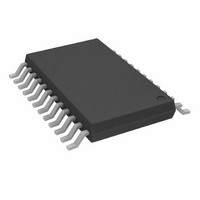AD7190BRUZ-REEL Analog Devices Inc, AD7190BRUZ-REEL Datasheet - Page 22

AD7190BRUZ-REEL
Manufacturer Part Number
AD7190BRUZ-REEL
Description
2ch UltraLow Noise 24Bit SD ADC IC.
Manufacturer
Analog Devices Inc
Datasheet
1.AD7190BRUZ.pdf
(40 pages)
Specifications of AD7190BRUZ-REEL
Design Resources
Precision Weigh Scale Design Using AD7190 with Internal PGA (CN0102)
Number Of Bits
24
Sampling Rate (per Second)
4.8k
Data Interface
DSP, MICROWIRE™, QSPI™, Serial, SPI™
Number Of Converters
1
Voltage Supply Source
Analog and Digital
Operating Temperature
-40°C ~ 105°C
Mounting Type
Surface Mount
Package / Case
24-TSSOP (0.173", 4.40mm Width)
Lead Free Status / RoHS Status
Lead free / RoHS Compliant
Available stocks
Company
Part Number
Manufacturer
Quantity
Price
Company:
Part Number:
AD7190BRUZ-REEL
Manufacturer:
ADI
Quantity:
1 000
Part Number:
AD7190BRUZ-REEL
Manufacturer:
ADI/亚德诺
Quantity:
20 000
AD7190
Table 18. Operating Modes
MD2
0
0
0
0
1
1
1
1
CONFIGURATION REGISTER
(RS2, RS1, RS0 = 0, 1, 0; Power-On/Reset = 0x000117)
The configuration register is a 24-bit register from which data can be read or to which data can be written. This register is used to
configure the ADC for unipolar or bipolar mode, to enable or disable the buffer, to enable or disable the burnout currents, to select the
gain, and to select the analog input channel.
Table 19 outlines the bit designations for the configuration register. CON0 through CON23 indicate the bit locations. CON denotes that
the bits are in the configuration register. CON23 denotes the first bit of the data stream. The number in parentheses indicates the power-
on/reset default status of that bit.
MD1
0
0
1
1
0
0
1
1
MD0
0
1
0
1
0
1
0
1
Mode
Continuous conversion mode (default). In continuous conversion mode, the ADC continuously performs conversions
and places the result in the data register. The DOUT/ RDY pin and the RDY bit in the status register go low when a
conversion is complete. The user can read these conversions by setting the CREAD bit in the communications
register to 1, which enables continuous read. When continuous read is enabled, the conversions are automatically
placed on the DOUT line when SCLK pulses are applied. Alternatively, the user can instruct the ADC to output each
conversion by writing to the communications register. After power-on, a reset, or a reconfiguration of the ADC, the
complete settling time of the filter is required to generate the first valid conversion. Subsequent conversions are
available at the selected output data rate, which is dependent on filter choice.
Single conversion mode. When single conversion mode is selected, the ADC powers up and performs a single
conversion on the selected channel. The internal clock requires up to 1 ms to power up and settle. The ADC then
performs the conversion, which requires the complete settling time of the filter. The conversion result is placed in
the data register, RDY goes low, and the ADC returns to power-down mode. The conversion remains in the data
register and RDY remains active (low) until the data is read or another conversion is performed.
Idle mode. In idle mode, the ADC filter and modulator are held in a reset state even though the modulator clocks are
still provided.
Power-down mode. In power-down mode, all AD7190 circuitry, except the bridge power-down switch, is powered
down. The bridge power-down switch remains active because the user may need to power up the sensor prior to
powering up the AD7190 for settling reasons. The external crystal, if selected, remains active.
Internal zero-scale calibration. An internal short is automatically connected to the input. RDY goes high when the
calibration is initiated and returns low when the calibration is complete. The ADC is placed in idle mode following a
calibration. The measured offset coefficient is placed in the offset register of the selected channel.
Internal full-scale calibration. A full-scale input voltage is automatically connected to the input for this calibration.
RDY goes high when the calibration is initiated and returns low when the calibration is complete. The ADC is placed
in idle mode following a calibration. The measured full-scale coefficient is placed in the full-scale register of the
selected channel. A full-scale calibration is required each time the gain of a channel is changed to minimize the full-
scale error.
System zero-scale calibration. The user should connect the system zero-scale input to the channel input pins as
selected by the CH7 to CH0 bits in the configuration register. RDY goes high when the calibration is initiated and
returns low when the calibration is complete. The ADC is placed in idle mode following a calibration. The measured
offset coefficient is placed in the offset register of the selected channel. A system zero-scale calibration is required
each time the gain of a channel is changed.
System full-scale calibration. The user should connect the system full-scale input to the channel input pins as
selected by the CH7 to CH0 bits in the configuration register. RDY goes high when the calibration is initiated and
returns low when the calibration is complete. The ADC is placed in idle mode following a calibration. The measured
full-scale coefficient is placed in the full-scale register of the selected channel. A full-scale calibration is required
each time the gain of a channel is changed.
Rev. B | Page 22 of 40














